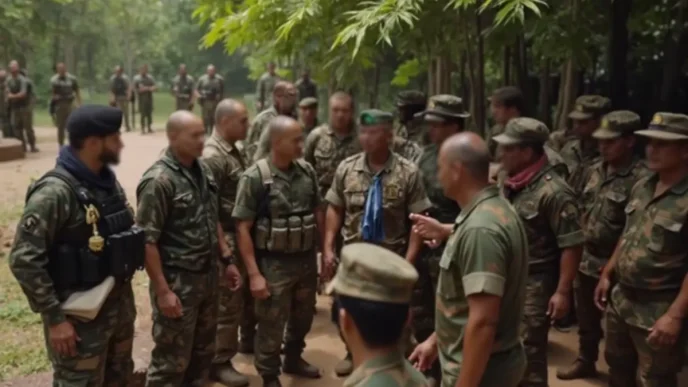A missing FA-50PH fighter jet belonging to the Philippine Air Force (PAF) has been located in the rugged terrain of the Kalatungan mountain range in Bukidnon province, southern Philippines. The discovery, announced on Wednesday, has intensified efforts to locate the two pilots who were aboard the aircraft when it lost contact during a mission to support ground troops battling communist rebels.
The jet, one of the PAF’s South Korean-made FA-50PH light combat aircraft, disappeared in the early hours of Tuesday while on a mission to provide air support in Bukidnon, a region in Mindanao known for ongoing clashes between government forces and the New People’s Army (NPA), the armed wing of the Communist Party of the Philippines. With the wreckage now identified, questions are mounting over the cause of the incident and the fate of the pilots, as search and rescue operations continue under challenging weather conditions.
A Race Against Time in Kalatungan
Lt Col Salvacion Evangelista, spokesperson for the Armed Forces of the Philippines’ Eastern Mindanao Command, confirmed the discovery during a press briefing in Davao City on Wednesday morning. “The wreckage of the FA-50PH has been located in the Kalatungan mountain range,” she told journalists, adding that rescuers are still scouring the area for the two pilots who were on board. The identities of the pilots have not been disclosed pending notification of their families.
The jet had taken off from Benito Ebuen Airbase in Mactan, Cebu, on Monday night, tasked with providing air support to government troops engaged in operations against NPA rebels in Bukidnon. According to the PAF, communication with the aircraft was lost shortly after midnight on Tuesday as it approached the target area. Gloomy weather and the mountainous terrain of Kalatungan, one of the highest ranges in Mindanao, have complicated search efforts, with soldiers airlifted by military helicopters working alongside civilian volunteers to comb the dense forest.
While the cause of the incident remains unclear, early speculation points to potential adverse weather conditions or technical issues with the aircraft. The FA-50PH, introduced to the PAF in 2015 as part of a modernisation programme, is a versatile light combat jet designed for both air-to-air and air-to-ground missions. However, operating in Mindanao’s often unpredictable weather and rugged landscape poses significant challenges, even for advanced aircraft.
Context of Conflict in Mindanao
The incident underscores the ongoing security challenges in Mindanao, where the Philippine government has been engaged in a decades-long insurgency against the NPA. The communist group, which seeks to overthrow the government through armed struggle, has maintained a presence in rural and mountainous areas like Bukidnon, often clashing with military forces. The region’s difficult terrain provides natural cover for guerrilla tactics, necessitating air support for ground operations—a role the missing FA-50PH was fulfilling when it lost contact.
Mindanao, the second-largest island in the Philippines, is no stranger to conflict. Beyond the NPA insurgency, the region has also grappled with separatist movements and the presence of Islamist militant groups, though the latter are more active in the western provinces like Sulu and Basilan. The Philippine government has made strides in recent years to address these issues, including a landmark peace agreement with the Moro Islamic Liberation Front (MILF) in 2014, which led to the creation of the Bangsamoro Autonomous Region in Muslim Mindanao (BARMM). However, sporadic violence involving the NPA and other armed groups continues to disrupt civilian life and strain military resources.
For the PAF, the loss of an FA-50PH—potentially the first such incident since the fleet’s introduction—raises concerns about operational readiness and the risks of conducting missions in hostile and environmentally challenging areas. The Philippines acquired 12 FA-50PH jets from South Korea’s Korea Aerospace Industries (KAI) between 2015 and 2017 as part of a broader effort to bolster its air defence capabilities amid territorial disputes in the South China Sea. The jets have since been deployed for various roles, including counter-insurgency operations in Mindanao.
Broader Implications for Philippine Security
As rescue teams work tirelessly to locate the missing pilots, the incident also shines a light on the broader state of the Philippine military. Despite recent modernisation efforts, including the acquisition of advanced equipment like the FA-50PH, the armed forces continue to face significant challenges, from budget constraints to the sheer scale of security threats across the archipelago. The loss of a fighter jet, even if due to environmental factors rather than enemy action, could prompt a reassessment of training protocols, mission planning, and equipment maintenance.
Moreover, the incident occurs at a time of heightened regional tension. While the NPA insurgency is a domestic issue, the Philippines remains a key player in South East Asian geopolitics, particularly given its strategic position in the South China Sea. The country’s military capabilities, including its air force, are often viewed through the lens of its ability to assert sovereignty in disputed maritime areas. Any perceived weakening of operational strength—such as the loss of a combat aircraft—could have ripple effects on regional perceptions of Philippine military readiness.
If adverse weather or mechanical failure is confirmed as the cause of the crash, it may also fuel discussions about the suitability of certain equipment for the unique challenges of Mindanao’s environment. The Kalatungan range, with its high peaks and dense vegetation, is notoriously difficult for aerial operations, and poor visibility during monsoon seasons can exacerbate risks. Alternatively, if hostile action by the NPA is found to have played a role—an unlikely but not impossible scenario, given the group’s limited anti-aircraft capabilities—it would mark a significant escalation in the conflict.
A Nation Awaits Answers
For now, the priority remains the safe recovery of the two missing pilots. Their families, along with the broader Filipino public, are awaiting updates with bated breath. The Philippine military has pledged to leave no stone unturned in the search, with additional resources being deployed to the Kalatungan area despite the difficult conditions. Civilian volunteers, many of whom are familiar with the local terrain, have also joined the effort, highlighting the community spirit often seen in times of crisis in the Philippines.
Beyond the immediate human toll, the incident serves as a stark reminder of the sacrifices made by the country’s armed forces in their efforts to maintain peace and security. The ongoing insurgency in Mindanao, while less prominent on the global stage than other regional conflicts, continues to exact a heavy cost on both military personnel and civilians caught in the crossfire. Each operation, whether on the ground or in the air, carries inherent risks—risks that the crew of the FA-50PH knew well when they took off from Mactan on Monday night.
As investigations into the cause of the incident begin, the Philippine government and military will face pressure to provide transparency and accountability. Was this a tragic accident caused by weather or mechanical failure, or does it point to deeper systemic issues within the PAF? The answers to these questions will shape not only the future of military operations in Mindanao but also public confidence in the government’s ability to address one of the country’s longest-running conflicts.
In the meantime, the nation holds onto hope for the safe return of the two pilots, whose mission to protect their country has now become a personal fight for survival in the mountains of Bukidnon.














